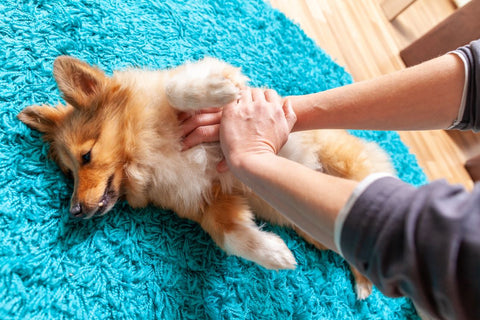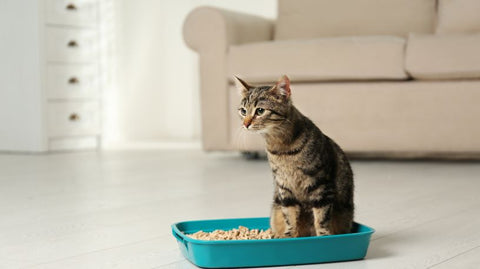

In this guide, we'll explore the signs indicating your cat needs first aid and provide essential tips on how to administer first aid effectively for some of the most common emergencies that can arise with our feline friends.
Common signs that may indicate your cat needs first aid include:
- Difficulty breathing/something blocking your cat's mouth
- Excessive drooling or foaming at the mouth
- Lethargy or weakness
- Bleeding or open wounds
- Difficulty urinating or defecating
- Vomiting or diarrhea lasting more than 24 hours
- Seizures or convulsions
- Inability to stand or walk
- Unconsciousness or collapse
Before administering first aid to your cat:
- Stay calm. Your cat can pick up on your emotions, and staying calm will help reassure them and facilitate the administration of first aid.
- Assess the situation. Approach your cat gently and cautiously to avoid causing further stress or injury.
- Contact a vet. If your cat is experiencing a medical emergency, such as difficulty breathing, seizures, or unconsciousness, contact your vet or an emergency vet clinic immediately for guidance and assistance.
- Provide supportive care. Keep your cat warm and comfortable while awaiting vet care. Monitor their vital signs and provide reassurance and comfort to alleviate stress and anxiety.
What Should I Have In A Cat First Aid Kit?
Having a well-stocked cat first aid kit for your cat is essential in handling emergencies effectively. Some key items to include in your cat first aid kit are:
1. Sterile gauze pads and bandages for wound care
2. Adhesive tape to secure bandages
3. Scissors (with blunt ends) to cut bandages or hair around wounds
4. Antiseptic wipes or solution to clean wounds
5. Digital thermometer to monitor your kitty's temperature
6. Tweezers to remove splinters or ticks
7. Hydrogen per oxide solution for wound cleaning
8. Latex gloves to protect yourself from bodily fluids
9. Thick towel or shirt to soak in cool water to cool a victim of heatstroke
10. Emergency contact numbers for your vet and local emergency vet clinic
Remember, being prepared and staying calm are crucial when providing first aid to your feline friend. By having a well-equipped first aid kit and knowing what to do in an emergency, you can help ensure your cat receives the care they need promptly and effectively.
Stabilizing Fractures with A Bandage
If you suspect your cat has a fracture, stabilize the injured limb by carefully immobilizing it with a splint or bandage. Avoid putting pressure directly on the injured area and transport your cat to a vet for further evaluation.
Addressing Burns or Wounds
For minor burns or wounds, clean the affected area with mild soap and water and apply a sterile dressing or bandage. Seek vet care if the injury is severe or if signs of infection develop.
Controlling Bleeding
Apply gentle pressure to the wound using a clean cloth or bandage to control bleeding. Elevate the injured limb if possible and seek vet care promptly.
What To Do If You Suspect Heatstroke
If you suspect your cat is experiencing heatstroke, it's crucial to act quickly. Move them to a cool, shaded area with proper ventilation and offer water to drink. Wet their fur with cool water (not cold water) and use a fan to help lower their body temperature. Coat an electric thermometer with a water-based lubricant, like petroleum jelly, and insert it 1-2 centimeters into their rectum to check their body temperature. A cat’s normal body temperature is 101 to 102 degrees Fahrenheit. Contact your veterinary hospital immediately for further instructions and seek emergency care if needed. It's important to cool their whole body, but be careful not to let them get too cold.
Remember, early intervention is key in providing first aid to your cat in emergencies such as heatstroke, so stay vigilant and act promptly to ensure their well-being.
Dealing with A Seizure: No Restraint
Dealing with a seizure in your furry friend can be a frightening experience. If your kitty is having a seizure, try to stay calm and make sure they are in a safe place where they won't get injured. Do not try to hold them down or put anything in their mouth.
Keep track of the duration of the seizure and contact your vet immediately. After the seizure, keep your cat warm and quiet, and monitor their breathing and general condition closely.
Seizures can have various underlying causes, so it's essential to seek veterinary care to determine the reason behind the seizure and develop a suitable treatment plan
How to Handle Poisoning
Common signs of poisoning in cats include:
- Vomiting
- Diarrhea
- Lethargy
- Difficulty breathing
- Seizures
- Drooling
- Trembling
- Loss of appetite
If you suspect your cat has been poisoned, stick to the 4 Cs:
1. Confine: Immediately remove your cat from the area to prevent further exposure. Safely confine her to a secure and quiet location away from potential hazards.
2. Call: Call your vet or an emergency animal poison control hotline immediately for guidance and assistance. Provide as much information as possible, including the type of toxin she may have been exposed to, the estimated amount ingested (if known), and any symptoms she is experiencing.
3. Collect: If safe to do so, collect any evidence of the suspected toxin, such as packaging, plant leaves, or any remaining substance, and bring it with you to the vet clinic for identification and treatment guidance.
4. Carry: Transport your feline friend to the nearest vet clinic or emergency animal hospital as soon as possible. If she is exhibiting severe symptoms or is unconscious, handle them gently and transport them in a secure carrier to prevent further injury or stress.
While awaiting vet care, monitor your cat closely for any changes in symptoms or behavior. Keep them calm and comfortable, and provide access to fresh water if they are able to drink.
Remember: Unless instructed by a vet or poison control expert, do not attempt to induce vomiting. Some substances can cause further harm if regurgitated or if they come into contact with the esophagus or mouth. If you suspect poisoning, call the Pet Poison Helpline at 1-800-213-6680 for immediate assistance and seek veterinary attention. It is also important to apply pressure to their abdomen, just below their ribcage, to potentially dislodge any harmful substances.
How do you perform CPR on a cat?
Performing CPR on a cat involves compressing the chest gently, just behind the cat's front legs, at a rate of 100-120 compressions per minute. After every 30 compressions, give 2 breaths through the cat's nose. It's vital to seek immediate veterinary care after administering CPR.
CPR for Cats
Performing CPR on a cat can save their life if their heart stops beating. It's essential to practice CPR techniques regularly to maintain proficiency and confidence in handling emergency situations involving cats. Here’s how to prepare for CPR:
- Have someone call for emergency vet assistance while you perform CPR.
- Before starting CPR, ensure that the environment is safe for both you and your pet. Check for any obstructions or hazards in the area.
- Gently tap your cat and call their name. Check for any signs of responsiveness such as movement, breathing, or vocalization. If your cat is unresponsive, lay your cat on a flat surface with their right side down. Ensure that their head and neck are in a neutral position to facilitate airway opening.
Proceed with CPR using the 4 Ps :
- Place: Place your hand on your cat's chest to feel for any breathing or pulse. Watch for chest movement and listen for breath sounds near your cat's nose and mouth. Check for a pulse by feeling for a heartbeat near the inner thigh or below the wrist.
- Press: If your cat is not breathing or has no pulse, begin chest compressions. Place the heel of one hand over the widest part of your cat's chest (just behind the front legs). Use your other hand to support your cat's back. Compress the chest by pushing down firmly but gently, aiming for a depth of about one inch for small cats and 1.5-2 inches for larger cats. Perform compressions at a rate of 100-120 compressions per minute.
- Puff: After every 30 compressions, provide rescue breaths. Close your cat's mouth and place your mouth over their nose. Exhale gently into their nostrils, watching for chest rise. Give two rescue breaths, ensuring that each breath lasts about one second.
- Pair: Alternate between chest compressions and rescue breaths in a ratio of 30 compressions to 2 breaths.
Continue CPR until your cat shows signs of recovery, such as breathing on their own, or until you reach a vet clinic for further assistance.
Keep in mind: Even if your cat responds to CPR, it's essential to seek vet care immediately. CPR is meant to provide temporary assistance until professional medical help can be obtained.
What About CPR for A Kitten?
CPR for kittens follows a similar approach to adult cats but with some adjustments due to their smaller size and fragility. When performing CPR on a kitten, it is crucial to be gentle and mindful of their delicate structure. Here are some key points to keep in mind:
- Adjust the depth of chest compressions: For kittens, aim for a compression depth of about 0.5-1 inch, as their chests are more delicate compared to adult cats.
- Be extra cautious with rescue breaths: Use very gentle puffs of air during rescue breaths to avoid causing damage to the kitten's lungs.
In times of emergency, knowing how to administer CPR to your cat can be lifesaving. Remember to compress the chest at the right depth and frequency, providing rescue breaths in between. It's crucial to maintain this cycle until your cat shows signs of improvement or until you can reach a vet for further care.
Contacting Your Vet
After performing the 4 Ps of CPR on your cat, it's crucial to remember that even if your feline friend responds positively, seeking veterinary care is essential. CPR serves as a temporary measure until you can get professional medical help. Contact your vet immediately to ensure your cat receives the necessary follow-up care and evaluation, including monitoring their blood flow and checking their muzzle for any potential obstructions. Time is of the essence in these situations, so swift action is key to giving your cat the best chance of recovery.
Hopefully this article on cat first aid has been helpful! Just remember: being prepared to administer first aid to your cat in times of need is a crucial aspect of responsible pet ownership. By familiarizing yourself with the signs indicating your cat needs first aid and equipping yourself with the necessary knowledge and skills to administer emergency care, including basic cat first aid, you can be better prepared to handle unexpected situations and provide timely and effective assistance to your feline companion. In some cases, basic first aid administered right away (or on the way to the vet) can help keep a dangerous situation from getting even worse—and might even be life-saving by buying you valuable time as you rush to emergency care. Remember to always contact your vet for proper medical care during an emergency.







